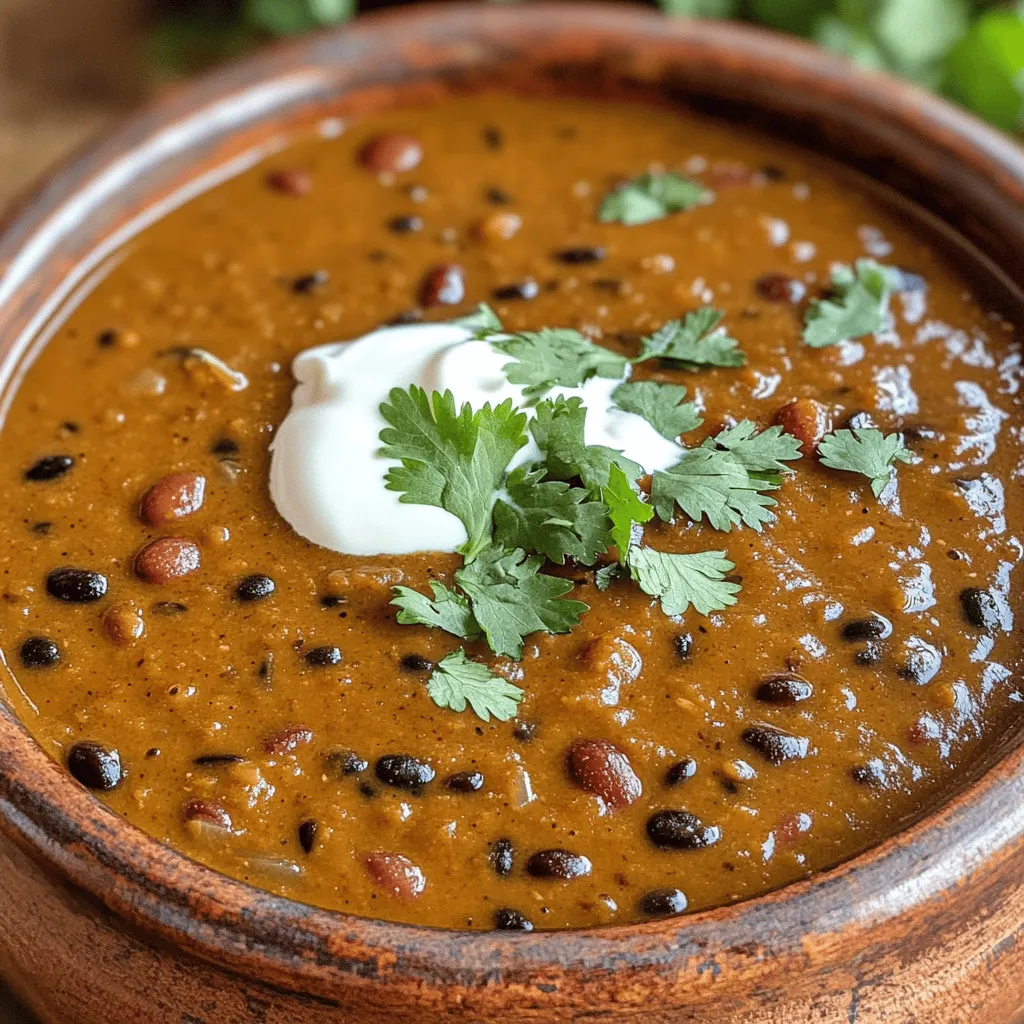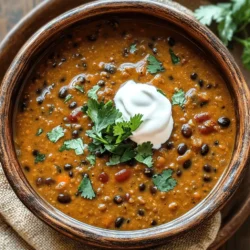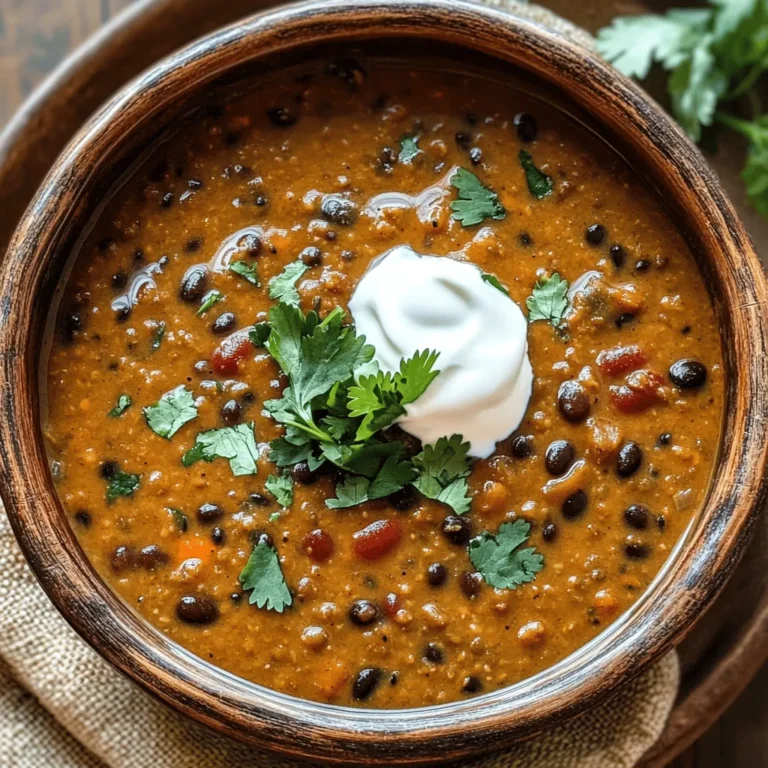If you’re craving a hearty dish that’s rich in flavor and easy to prepare, you’ve come to the right place. I’m excited to share my go-to recipe for Slow Cooker Dal Makhani, a creamy delight that combines black lentils and kidney beans in a blend of spices. With just a few simple steps, you can create a meal that’s both comforting and satisfying. Let’s dive into the ingredients and get started!
Ingredients
Essential Ingredients for Slow Cooker Dal Makhani
– 1 cup black lentils (urad dal)
– 1/3 cup red kidney beans (rajma)
– 1 large onion, finely chopped
– 2 tomatoes, pureed
– 4 cloves garlic, minced
– 1 inch ginger, grated
– 2 green chilies, slit lengthwise
– 1 teaspoon cumin seeds
– 1 teaspoon garam masala
– 1 tablespoon butter
– 1/2 cup heavy cream or coconut cream
– 2 teaspoons salt or to taste
– Fresh cilantro leaves for garnish
– 4 cups water
Optional Ingredients for Flavor Enhancement
– Additional spices (e.g., turmeric, paprika)
– Lemon juice for acidity
– Extra butter or ghee for richness
To make the best Slow Cooker Dal Makhani, you need a mix of rich ingredients. Black lentils and kidney beans are the main stars. They give the dish its creamy texture and hearty feel. Chopped onions, pureed tomatoes, garlic, and ginger bring depth and warmth. Green chilies add a touch of heat, while cumin seeds and garam masala create a fragrant aroma.
I love adding butter for a silky finish, and cream for that rich flavor. If you prefer a vegan option, coconut cream works great too. Don’t forget to season with salt and garnish with fresh cilantro for color.
For an extra boost of flavor, consider turmeric or paprika. A squeeze of lemon juice can brighten the dish, and a touch of extra butter or ghee can enhance richness.
This mix of ingredients creates a delicious and satisfying meal that is easy to make in your slow cooker.
Step-by-Step Instructions
Preparation Steps Before Cooking
– Rinse and soak lentils and beans
– Drain the soaked lentils and kidney beans
Start by rinsing the black lentils and kidney beans under cold water. This helps remove dirt and impurities. Soak them in water for about eight hours, or overnight for best results. Soaking softens the beans and lentils, making them cook better. After soaking, drain them well. This step is key to ensure your dish is smooth and creamy.
Cooking Process in Slow Cooker
– Combine lentils, kidney beans, and water in the slow cooker
– Sauté and add spices to enhance flavors
– Mix sautéed ingredients into the slow cooker
– Set cooking time and temperature (low or high)
Next, add the soaked lentils and kidney beans into your slow cooker. Pour in four cups of water. This is where the magic begins! In a pan, melt some butter over medium heat. Add cumin seeds and let them splutter, releasing a warm aroma. Then, add chopped onions and sauté until they turn golden brown.
Add minced garlic, grated ginger, and slit green chilies. Sauté for two to three minutes until fragrant. Pour in the pureed tomatoes and let everything cook together for five to seven minutes. This step brings out the rich flavors. Once done, mix this sautéed goodness into the slow cooker with the lentils and beans. Stir well. Add salt and garam masala, cover, and set your slow cooker. Cook on low for six to eight hours or on high for four to five hours. Your Dal Makhani will become tender and flavorful.
Final Touches Before Serving
– Stir in heavy cream or coconut cream
– Adjust seasoning and garnish with cilantro
About 30 minutes before serving, stir in the heavy cream or coconut cream. This adds a rich, creamy texture that everyone loves. Taste your dish and adjust the seasoning if needed. Finally, garnish with fresh cilantro leaves before serving. This not only adds color but also a fresh burst of flavor. Your Dal Makhani is now ready to enjoy!
Tips & Tricks
Perfecting Your Dal Makhani
Soaking black lentils and kidney beans is key. I recommend soaking them for 8 hours or overnight. This helps them cook faster and makes them creamier.
Before you add the spices to the slow cooker, sauté them first. This brings out their true flavors. Start with cumin seeds in some butter until they pop. Then, add onions and let them turn golden. This step makes a big difference!
Enhancing Flavor Profiles
Choosing the right spices is vital. I find that a mix of garam masala and cumin works best. You can also add turmeric for color and warmth.
For toppings, consider fresh cilantro and a swirl of cream. A squeeze of lemon juice can also brighten the dish. These extra touches will elevate your Dal Makhani.
Cooking Time Adjustments
Cooking times can vary by slow cooker. If yours runs hot, check after 4 hours on high. For cooler models, you may need up to 8 hours on low.
Dal Makhani is done when the lentils and beans are soft and creamy. You should be able to mash them easily with a fork. This is when you know it’s time to enjoy your rich and creamy delight!

Variations
Vegan Version of Dal Makhani
You can easily make a vegan version of Dal Makhani. Instead of using heavy cream, try coconut cream or cashew cream. Both options give a rich and creamy texture. Coconut cream adds a subtle sweetness and a hint of tropical flavor. Cashew cream has a mild taste and blends well with spices. Simply blend soaked cashews with water for a smooth cream. This keeps your Dal Makhani rich without dairy.
Regional Variations
Dal Makhani varies across India. Each region has its own twist. For example, Punjab is famous for its buttery version. In southern India, you might find a spicier variation using local spices. You can add fresh ingredients like curry leaves or asafoetida. These local flavors make the dish unique. Don’t hesitate to experiment with your local spices to create a new version that suits your taste.
Heat Level Adjustments
Adjusting the spice level is easy. If you prefer milder dishes, remove the seeds from the green chilies. You can also use less chili powder. For a spicier kick, add more green chilies or a pinch of cayenne. I recommend trying garam masala blends for different heat levels. Some blends mix sweet and hot spices, which can enhance the flavor without overwhelming heat. Always taste as you go to find your perfect balance.
Storage Info
How to Properly Store Dal Makhani
To keep your Dal Makhani fresh, store leftovers in the fridge. Use an airtight container to prevent moisture loss. It’s best to let the dish cool before sealing it up. You can enjoy it for up to four days this way.
If you want to save Dal Makhani for later, freezing works great too. Use freezer-safe containers or heavy-duty freezer bags. Be sure to leave some space in the container, as the dish might expand. It can stay frozen for up to three months.
Reheating Instructions
When you’re ready to enjoy the leftovers, the best method to reheat is on the stove. Pour the Dal Makhani into a saucepan and heat over low to medium heat. Stir it often to keep it from sticking.
You can also reheat it in the microwave. Just place it in a microwave-safe bowl, cover it, and heat in short bursts. Stir in between to ensure even heating.
To keep the creamy texture, add a splash of water or cream while reheating. This helps revive that rich, smooth feel.
Shelf Life
Dal Makhani can be stored safely in the fridge for about four days. If frozen, it lasts for three months. Always check for signs that it has spoiled. Look for any off smells or changes in color. If it smells sour or looks unusual, it’s best to toss it.
Enjoy the rich and creamy delight of your Dal Makhani, knowing you can savor it again!
FAQs
What is the best way to soak lentils and beans?
To soak lentils and beans, rinse them well in cold water. Then, place them in a bowl and cover with fresh water. Soak for about 8 hours or overnight. This softens them, making them cook faster. It also helps remove some of the gas-causing compounds. If you’re short on time, a quick soak works too. Boil them for 2 minutes, then let them sit for an hour.
Can I use dried lentils and beans instead of canned?
Yes, you can use dried lentils and beans. Just remember to soak them first. Dried legumes give better flavor and texture. They also tend to be cheaper. Canned options save time but may have added sodium. If you choose canned, rinse them to cut down on salt. Adjust cooking times as needed. Dried beans will take longer to cook than canned.
What to serve with Slow Cooker Dal Makhani?
Dal Makhani pairs well with naan, rice, or roti. You can also serve it with a fresh salad or yogurt. A side of pickles adds a nice tang. For a complete meal, add some grilled vegetables. These sides complement the rich, creamy flavors. You can also try serving it in a bowl topped with fresh cilantro.
Can I adjust the recipe for larger servings?
You can easily scale the recipe to serve more people. Just double or triple the ingredients. Keep the same cooking time, but check for doneness. You may need a larger slow cooker for bigger batches. Make sure to keep the flavor balanced. Adjust spices to your taste as you increase the quantity.
Is Slow Cooker Dal Makhani healthy?
Yes, Slow Cooker Dal Makhani is healthy. It is rich in protein and fiber. Black lentils and kidney beans provide essential nutrients. Adding cream adds richness but also calories. To lighten it, you can use coconut cream. This dish is filling and nutritious, perfect for a balanced meal.
How to make this dish spicier?
To add spice, use more green chilies or add red chili powder. You can also try cayenne pepper for extra heat. Start with a little and taste as you go. This way, you control the heat without losing flavor. If it gets too spicy, balance it with more cream. This keeps the dish creamy and delicious.
In this blog post, we explored how to make Slow Cooker Dal Makhani. We discussed essential and optional ingredients, detailed step-by-step cooking instructions, and offered useful tips. You can also enjoy vegan versions and regional variations for more flavor. Proper storage and reheating methods ensure you enjoy leftovers. Dal Makhani provides great taste with nutritional benefits you can feel good about. Enjoy making this dish and have fun experimenting with your flavors. Happy cooking!


